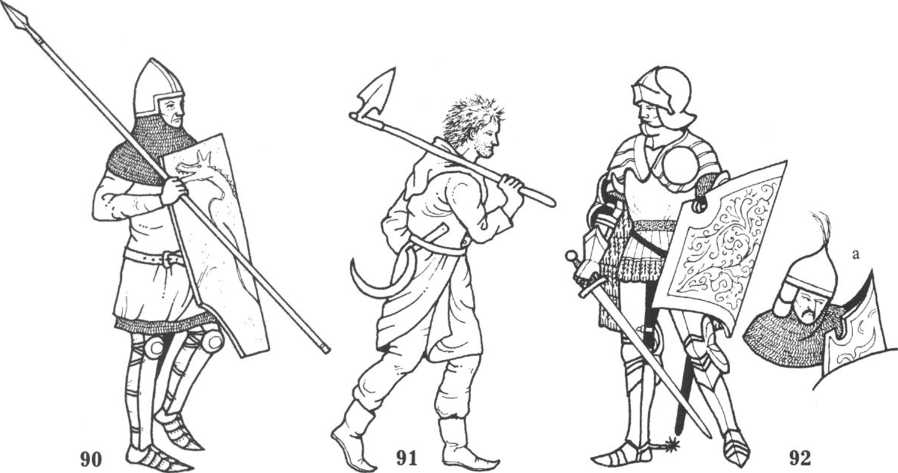One further type of foot-soldier to appear in 15th centuy Hungarian — or more specifically Transylvanian — armies under Janos Hunyadi was the peasant volunteer or crusader, repeatedly mentioned in particular in many contemporary chronicles of the 1440s and 1450s. The ‘Historia Boemica’ says that only a third of these were or became competent at handling arms, the remainder fighting instead with typical peasant weapons of sling and scythe. Giovanni di Tagliacozzo also wrote that those present at Belgrade in 1456 were armed with swords, stakes, slings, clubs, stone-throwers (stone-bows?), bows, and iron hooks to unhorse the Ottoman cavalry, but mentions that some (presumably amongst those trained up by Hunyadi) had handguns firing lead bullets. In Hungary itself serfs armed with scythes and other agricultural implements performed sterling service against Bohemian invaders and routed Ottomans alike in 1465 and 1479.
92. HUNGARIAN MAN-AT-ARMS c. 1445
Because of its geographic location Hungary was subjected to both Italian and German influences in armour design, and although the latter generally predominated the former seems to have remained popular well into the 15th century. The figure depicted here is actually from an Italian fresco of 1445-50 depicting the Florentine condottiere Filippo Scolari (nicknamed Pippo Spano by his contemporaries), who went to Hungary at the age of 13. He fought at Nicopolis in 1396, by 1407 was ispan or count of Temes, and commanded Hungarian armies for King (later Emperor) Sigismund in Italy 1411-12, in South Hungary and Serbia, in Bosnia 1416, against the Hussites 1420-22, and in Wallachia 1423-27. He wears characteristic Italian armour of the period, described under figures 77 and 122 in volume 1, with a pale blue silk surcoat over it that has hanging sleeves as described under figure 109 below. The sleeves and fringe to the skirt of his surcoat are gold with red decoration; in addition his stockings and tunic sleeves (visible on the insides of his thighs and elbows) are also red, as is the waist-belt.

His helmet and shield are added from other sources. The shield evolved from the type described under figure 73. Adopted under Serbian influence, it seems to have appeared in Hungary during the first half of the 15th century (Taking includes a picture of one which is claimed to date from the ‘early’ 15th century25), that illustrated here belonging to the second half of the century. From Hungary or Serbia, this so-called wing-shield was adopted in turn by the Ottoman Turks, and it is the predominant type of Turkish shield depicted in 16th century illustrations. In fact the Ottomans had actually begun to adopt it before the end of the period under review, the earliest Ottoman picture of such a shield that I have seen dating to c. 1500; this is shown in 92a, and is red with a gilt rim and decoration.




 World History
World History









